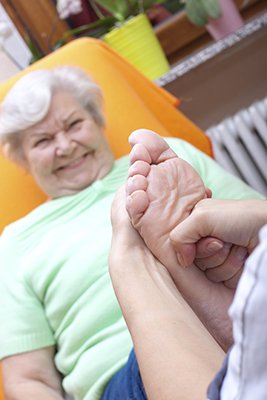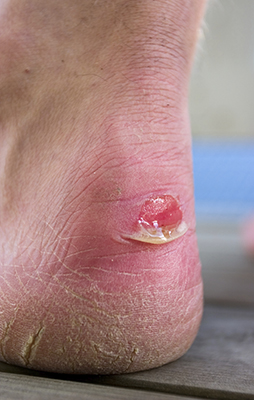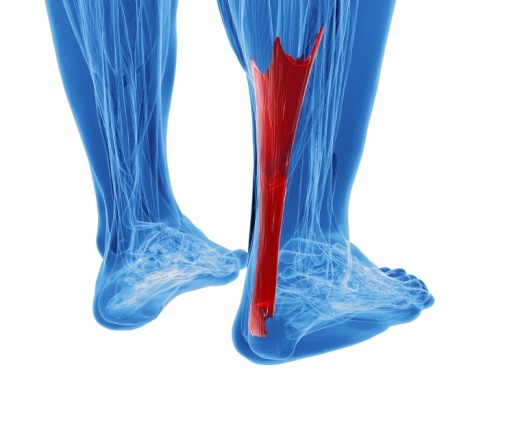Diabetic Foot is a Major Cause of Hospitalization
 Diabetic foot is one of the top 20 causes of hospitalization in Australia. Studies conducted in the country found that one in every twenty-two patients in Australian hospitals have active diabetic foot disease. The disease is also responsible for over 4,400 amputations and 1,700 deaths each year. Nevertheless, early prevention is the best way to assure that diabetic foot does not progress into something much worse. It is recommended that every diabetic who goes to a hospital asks to have their foot screened for diabetic foot. Many people who have the disease often aren’t aware of it.
Diabetic foot is one of the top 20 causes of hospitalization in Australia. Studies conducted in the country found that one in every twenty-two patients in Australian hospitals have active diabetic foot disease. The disease is also responsible for over 4,400 amputations and 1,700 deaths each year. Nevertheless, early prevention is the best way to assure that diabetic foot does not progress into something much worse. It is recommended that every diabetic who goes to a hospital asks to have their foot screened for diabetic foot. Many people who have the disease often aren’t aware of it.
Diabetic foot care is important in preventing foot ailments such as ulcers. If you are suffering from diabetes or have any other concerns about your feet contact Dr. Steven Shlonsky of Kentucky. Dr. Shlonsky can provide the care you need to keep your pain free and on your feet.
Diabetic Foot Care
Diabetes affects millions of people every year. Diabetes can damage blood vessels in many parts of the body, including the feet. Because of this, taking care of your feet is essential if you have diabetes, and having a podiatrist help monitor your foot health is highly recommended.
The Importance of Caring for Your Feet
- Routinely inspect your feet for bruises or sores.
- Wear socks that fit your feet comfortably.
- Wear comfortable shoes that provide adequate support.
Patients with diabetes should have their doctor monitor their blood levels because blood sugar levels play such a huge role in diabetic care. Monitoring these levels on a regular basis is highly advised.
It is always best to inform your healthcare professional of any concerns you may have regarding your feet, especially for diabetic patients. Early treatment and routine foot examinations are keys to maintaining proper health, especially because severe complications can arise if proper treatment is not applied.
If you have any questions please feel free to contact one of our offices located in Louisville, KY. We offer the newest diagnostic and treatment technologies for all your foot and ankle needs.
Read more about Diabetic Foot Care
Caring for Blisters
 Blisters are a fairly common foot condition that can be easily prevented with a few simple steps. The first step is to always ensure the feet or kept clean to prevent any germs or bacteria from penetrating the skin. Wearing the right pair of socks can also help support the feet and reduce friction, which can create blisters. Applying bandages or band aids to any already existing blisters can help reduce excess heat or additional friction that can exacerbate the blister.
Blisters are a fairly common foot condition that can be easily prevented with a few simple steps. The first step is to always ensure the feet or kept clean to prevent any germs or bacteria from penetrating the skin. Wearing the right pair of socks can also help support the feet and reduce friction, which can create blisters. Applying bandages or band aids to any already existing blisters can help reduce excess heat or additional friction that can exacerbate the blister.
Blisters are prone to making everyday activities extremely uncomfortable. If your feet are hurting, contact Dr. Steven Shlonsky of Kentucky. Dr. Shlonsky will assist you with all of your podiatric concerns.
Foot Blisters
Foot blisters develop as a result of constantly wearing tight or ill-fitting footwear. This happens due to the constant rubbing from the shoe, which can often lead to pain.
What are Foot Blisters?
A foot blister is a small fluid-filled pocket that forms on the upper-most layer of the skin. Blisters are filled with clear fluid and can lead to blood drainage or pus if the area becomes infected.
How do Blisters Form?
Blisters on the feet are often the result of constant friction of skin and material, usually by shoe rubbing. Walking in sandals, boots, or shoes that don’t fit properly for long periods of time can result in a blister. Having consistent foot moisture and humidity can easily lead to blister formation.
Prevention & Treatment
It is important to properly care for the affected area in order to prevent infection and ease the pain. Do not lance the blister and use a Band-Aid to provide pain relief. Also, be sure to keep your feet dry and wear proper fitting shoes. If you see blood or pus in a blister, seek assistance from a podiatrist.
If you have any questions please contact our offices located in Louisville, KY. We offer the newest diagnostic and treatment technologies for all your foot and ankle needs.
Read more about blisters on the feet
Ways to Treat Bunions
 Hallux valgus, which is more commonly known as a bunion, is a deformity of the joint at the base of the big toe. Most people who have bunions develop them from wearing uncomfortable shoes for a long period of time. Women are more likely to have bunions compared to men because they often wear high heels. Bunions are not a life threatening condition; however they can negatively impact one’s quality of life. There are a few non-surgical options for those wishing to treat their bunions. Physiotherapy and the use of devices such as bunion splints and toe spacers can work to alleviate bunion pain; however they may not be effective in the long run.
Hallux valgus, which is more commonly known as a bunion, is a deformity of the joint at the base of the big toe. Most people who have bunions develop them from wearing uncomfortable shoes for a long period of time. Women are more likely to have bunions compared to men because they often wear high heels. Bunions are not a life threatening condition; however they can negatively impact one’s quality of life. There are a few non-surgical options for those wishing to treat their bunions. Physiotherapy and the use of devices such as bunion splints and toe spacers can work to alleviate bunion pain; however they may not be effective in the long run.
Bunion surgery usually occurs after non-surgical methods have proved to be ineffective. If you have any concerns, contact Dr. Steven Shlonsky of Kentucky. Dr. Shlonsky will assess your injury and provide you with quality treatment.
What is a Bunion?
A bunion is formed of swollen tissue or an enlargement of boney growth, usually located at the base joint of the toe that connects to the foot. The swelling occurs by the bones in the big toe shifting inward, which impacts the other toes of the foot. This causes the area around the base of the big toe to become inflamed and painful.
Why do Bunions Form?
- Genetics – susceptibility to bunions are often hereditary
- Stress on the feet – poorly fitted and uncomfortable footwear that places stress on feet, such as heels, can cause bunions to form
How are Bunions Diagnosed?
Doctors often perform two tests – blood tests and x-rays – when trying to diagnose bunions, especially in the early stages of development. Blood tests help determine if the foot pain is being caused by something else, such as arthritis, while x-rays provide a clear picture of your bone structure to your doctor.
How are Bunions Treated?
- Refrain from wearing heels or similar shoes that cause discomfort
- Select wider shoes that can provide more comfort and reduce pain
- Anti-inflammatory and pain management drugs
- Orthotics or foot inserts
- Surgery
If you have any questions, please feel free to contact our office located in Louisville, KY. We offer the newest diagnostic and treatment technologies for all your foot care needs.
Read more about bunions.
Using RICE to Treat Ankle Sprains
 The RICE method is commonly used to treat ankle sprains. The acronym “RICE” stands for rest, ice, compression, and elevation. However there has been some uncertainty about whether or not icing your sprained ankle will be beneficial in the healing process. Some athletic trainers believe that icing your injury will prevent blood flow to the area and delay healing. Nevertheless, icing will help numb the pain and reduce swelling in the injured area, but you should not place it directly on your skin. You should place a thin piece of cloth between the ice and your skin, and avoid icing for more than twenty minutes at a time in order to avoid frostbite.
The RICE method is commonly used to treat ankle sprains. The acronym “RICE” stands for rest, ice, compression, and elevation. However there has been some uncertainty about whether or not icing your sprained ankle will be beneficial in the healing process. Some athletic trainers believe that icing your injury will prevent blood flow to the area and delay healing. Nevertheless, icing will help numb the pain and reduce swelling in the injured area, but you should not place it directly on your skin. You should place a thin piece of cloth between the ice and your skin, and avoid icing for more than twenty minutes at a time in order to avoid frostbite.
Ankle sprains are common, but need immediate attention. If you have any concerns, contact Dr. Steven Shlonsky of Kentucky. Dr. Shlonsky will assist you with all of your foot and ankle needs.
How Does an Ankle Sprain Occur?
Ankle sprains take place when the ligaments in your ankle are torn or stretched beyond their limits. There are multiple ways that the ankle can become injured, including twisting or rolling over onto your ankle, putting undue stress on it, or causing trauma to the ankle itself.
What are the Symptoms?
- Mild to moderate bruising
- Limited mobility
- Swelling
- Discoloration of the skin (depending on severity)
Preventing a Sprain
- Wearing appropriate shoes for the occasion
- Stretching before exercises and sports
- Knowing your limits can aid in prevention
Treatment of a Sprain
Treatment of a sprain depends on the severity. Many times, people are told to rest and remain off their feet completely, while others are given an air cast. If the sprain is very severe, surgery may be required.
If you have suffered an ankle sprain previously, you may want to consider additional support such as a brace and regular exercises to strengthen the ankle.
If you have any questions, please feel free to contact our office located in Louisville, KY. We offer the newest diagnostic and treatment technologies for all your foot care needs.
Read more about ankle sprains.
Sakho Sidelined with Achilles Tendon Injury
 Liverpool’s defender, Mamadou Sakho, is expected to be sidelined for a month due to an Achilles tendon injury. He is currently doing rehab assignments and will be reassessed to see when he can resume playing. Sakho was suspected of violating the league’s drug policy and missed a large chunk of last season. He was looking forward to play with his team again, but this injury serves as another setback for his return.
Liverpool’s defender, Mamadou Sakho, is expected to be sidelined for a month due to an Achilles tendon injury. He is currently doing rehab assignments and will be reassessed to see when he can resume playing. Sakho was suspected of violating the league’s drug policy and missed a large chunk of last season. He was looking forward to play with his team again, but this injury serves as another setback for his return.
Achilles tendon injuries need immediate attention to avoid future complications. If you have any concerns, contact Dr. Steven Shlonsky of Kentucky. Dr. Shlonsky will treat your foot and ankle needs.
What is the Achilles Tendon?
The Achilles tendon is a tendon that connects the lower leg muscles and calf to the heel of the foot. It is the strongest tendon in the human body and is essential for making movement possible. Because this tendon is such an integral part of the body, any injuries to it can cause severe difficulties and should immediately be presented to a doctor.
What are the symptoms of an Achilles Tendon Injury?
There are various types of injuries that can affect the Achilles tendon. The two most common are Achilles tendinitis and ruptures of the tendon.
Achilles Tendinitis Symptoms
- Inflammation
- Dull to Severe Pain
- Increased blood flow to the tendon
- Thickening of the tendon
Rupture Symptoms
- Extreme pain and swelling in the foot
- Total immobility
Treatment and Prevention
Achilles tendon injuries are diagnosed by a thorough physical evaluation, which can include an MRI. Treatment involves rest, physical therapy, and in some cases, surgery. However, various preventative measures can be taken to avoid these injuries, such as:
- Thorough stretching of the tendon before and after exercise
- Strengthening exercises like calf raises, squats, leg curls, leg extensions, leg raises, lunges, and leg presses
If you have any questions please feel free to contact our office located in Louisville, KY. We offer the newest diagnostic and treatment technologies for all your foot and ankle needs.







